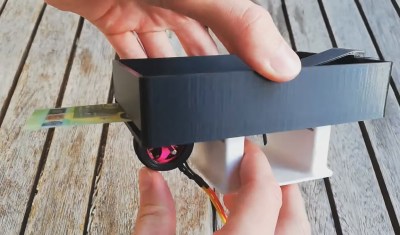For anyone playing the stock market, and perhaps even more so for those investing in cryptocurrencies, watching the value of your portfolio go up and down can be a stressful experience. If you’d like to have a real-time display of your investments that adds even more stress, [Luis Marx] has got you covered. His latest project is a plexiglass case (video in German) that fills up with banknotes when your portfolio is up, and shreds those same notes when it’s down.
Inspired by an infamous Banksy artwork, [Luis] began by building a wood-and-plexiglass display case suitable for hanging on the wall in his office. He then installed a small paper shredder, modified with a servo so that it could be operated by an Arduino. Unable to find an off-the-shelf banknote dispenser, he designed and 3D-printed one, consisting of a spring-loaded tray and a motor-driven wheel.

The project also includes a Raspberry Pi, programmed to fetch market data from online sources and calculate the net profit or loss of [Luis]’s portfolio. The resulting system is a rather disturbing visualization of the ups and downs of the market: having to sweep strips of green paper off your floor adds insult to the pain of losing money.
If you want a less painful way to keep track of your investments, try this Rocketship. For those interested in traditional stock tickers, this ESP32 based one might be more to your liking.
















Does it tape your money back together when the stock goes back up?
This is not bitcoin :D
Of course not. But the money artsy processed that way has an increased value !
Or print more money? It seems banksy is a pessimist and only sees the down side.
Or just some hyper-inflation currency, (e.g. Venezuela, Zimbabwe).
I was thinking about this too. To solve the problem, I might use a technique similar to the “money printing” toy that looks like a couple of rollers, but really is a rolled-up belt on two axles. So unshredded money would go in one side, and pre-shredded money would come out the other side, and it can run either way (up to a point). You might want to add a speaker to make shredding sounds as the market goes down, and maybe sewing machine sounds when it goes up.
Brilliant!
Pretty cool!
I like Banksy, but for the original piece, he lost credibility when he held the soldering iron by the hot part; he wouldn’t hear the end of it around here. Still a neat concept though, and the fact that it failed made it even better.
Holding the soldering iron by the hot part? That’s like when you see a Penn and Teller card trick and the person picks the three of clubs. It’s a wink to all the people who know.
I checked my stock right before checking Hackaday… It’s like Robin knew…
Jam some Hungarian Forints in there!
Unless you sell your stock at below what you paid for it, or a company you invested in goes out of business or bankrupts and goes *poof* without anyone buying the assets, you haven’t lost money when the price drops. A stock might spike high for a bit then drop to a low value from which it never recovers, and if you bought in while it was rising then were dumb and held onto it for too long, until it fell below what you paid, well your investment has depreciated. But as long as you still have the stock, there could be a chance of it going back up, or some other company buying that company. But as for actually losing the money, not until you sell it.
The smart investor spreads the money across several stocks that have been observed to have a periodic rise and fall, or “churn”. Buy at a low point then as soon as it goes up a bit, sell. Repeat over and over, and each time keep back a bit until you’ve recovered your initial investment.
From then on it’s all “play money”. Do it right and if you start in your 20’s you could retire with millions by age 35. That’s what a co-worker of one of my cousins did while working at Micron. Started with $1,000 and retired rich in his mid 30’s. He offered to tell my cousin how to do it but cousin’s wife refused to let him take $1,000 out of their savings.
An article I read years ago on successful day traders emphasized that you should never hold onto any stock overnight, because you never know what might cause a fast plunge right after the market opens. Watch the churns and don’t get greedy hoping for one last ‘wave’ near the end of the market day. Like a good surfer, know when to get out of the water.
Isn’t destroying banknotes illegal in most countries?
It probably is…
But, I argue that permanently removing fiat currency notes, actually (albeit minutely), increases the value of the remaining currency. The one who destroys their own currency notes loses its value, but the value of the remaining paper increases. It is opposite of governments just printing more money that has no intrinsic value (inflation).